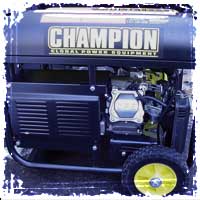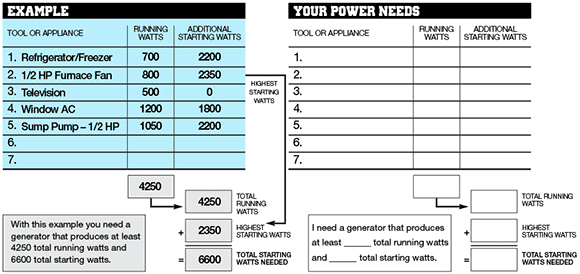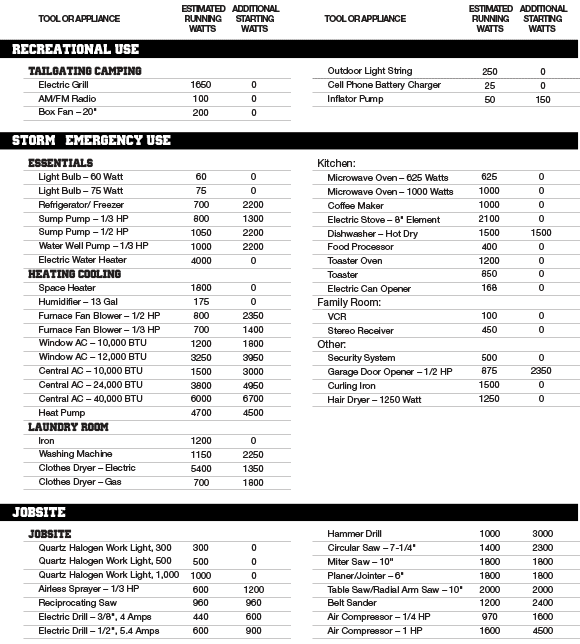The Size of your generator depends on your unique power needs; these needs have to be determined before ever purchasing an emergency generator.
This worksheet is designed to help you determine the right size generator for your situation.
- Select the items you wish to power at the same time. Using the table below, fill in the running watts and additional starting watt requirements on the “Your Power Needs” worksheet.
- Add the running watts of the items you wish to power. Enter this number in the Total running watts column.
- Select the one individual item with the highest number of starting watts. Take this one number, add it to your total running watts, and enter the total in the Total starting watts box.
Click Here to Download a Printable Version of the Wattage Worksheet
 Once you have determined how many watts you will need, make sure to select a generator that runs slightly above your peak wattage. Continuously running a generator at peak wattage will quickly burn the generator out.
Once you have determined how many watts you will need, make sure to select a generator that runs slightly above your peak wattage. Continuously running a generator at peak wattage will quickly burn the generator out.
You also need to keep in mind that bigger doesn’t always mean better. If you buy a 7500 watt generator and you only need something that can handle 2500 watts, you are going to be wasting a significant amount of fuel. This is something that you should factor into your decision since fuel will become more expensive and harder to find during times of crisis.
Frequently Asked Emergency Generator Questions
How many watts does it take to power basic items in an average size house?
To run the essential items found in the average American home, you will need somewhere around 5,000 – 7,500 watts of power. This will of course vary from home to home, but it’s a good estimate to start with.
What is the difference between running watts and starting watts?
When selecting an emergency generator system, you need to calculate both your running and your starting wattage requirements.
- Running, or rated watts are the continuous amount of watts needed to continually run your appliances.
- Starting wattage is the additional amount of electricity required to start commonly found motor-driven products like refrigerators or other household appliances.
When selecting a generator you should always factor in the appliances with the highest additional starting watts.
Maximum vs. Rated Power
Generators are often advertised with the maximum wattage they can produce, this is not the number you should be looking at. If you continually operate your generator at this wattage, it will quickly burn out. Look for something called the “rated power” to determine if a generator will be able to adequately power your appliances continuously.
- Maximum power = the maximum output a generator can produce. Maximum power is usually available for up to 30 minutes.
- Rated power = the power a generator can produce for long periods of time. This is often 90% of the maximum power.
Why is only one additional starting watt item used to calculate your total starting watt requirements?
Unlike running watts, starting watts are only needed during the first couple seconds of operation. In most cases, only one item will start or cycle at the same time, therefore this is the most accurate estimate.
What if I can’t determine the running or the starting watt requirement for a tool or appliance?
Each appliance should have a sticker that tells you exactly how much continuous wattage is needed to power the device. If the running watts are not on the item, you may estimate them using the following equation: WATTS = VOLTS x AMPS.
Only motor-driven items will require additional starting watts. The additional starting watts required may be estimated at 1 – 2x the running/rated watts.
My appliance is an 800 watt model, but it takes 1500 watts to run it. Why?
You really need to read your labels, because some devices can be deceptive. Just because an appliance is labeled as an 800 watt model, doesn’t mean it takes only 800 watts to run that appliance. For example, a microwave oven might be labeled as an 800 Watt oven, but it may require more wattage to power the device.
Generator Safety Tips:
A generators exhaust contains toxic carbon monoxide, which you cannot see or smell. NEVER operate your generator inside your home, and make sure to keep it far away from any doors and windows. Carbon monoxide fumes can KILL YOU IN MINUTES, please take all necessary precautions, and make sure you follow the directions in your owner’s manual.
Make sure you start your generator when you first buy it, and then at least once every month thereafter. The last thing you want to find out during a grid down situation is that your fancy new generator doesn’t work.
When operating your generator, make sure it is securely fastened to something that cannot be moved. These are a very popular item for thieves, and during a disaster they are often stolen from people’s land. Keep in mind generators are loud; so when you’re running one, it’s very likely people within your vicinity will hear it.
by Robert Richardson
Source:offgridsurvival.com






